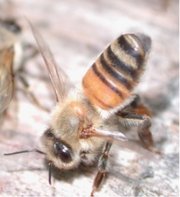Pheromone
|
|
A pheromone is any chemical produced by a living organism that transmits a message to other members of the same species. There are alarm pheromones, food trail pheromones, sex pheromones, and many others. Their use among insects has been particularly well documented, although many vertebrates also communicate using pheromones. Their use by humans is controversial.
Insect pheromones of pest species, such as the Japanese beetle and the gypsy moth, can be used to trap them or to create confusion so that the pests do not lay eggs on crops.
In mammals and reptiles, pheromones may be detected by the vomeronasal organ, or Jacobson's organ, which lies between the nose and mouth, although some are detected by regular olfactory membranes.
Human pheromones
Pheromones are a popular device in fiction, including the novel Jitterbug Perfume by Tom Robbins and the film Love Potion Number Nine. They were also mentioned in an episode of Wolfgang Petersen's The Agency.
Some commercially-available substances are advertised using claims that the products contain sex pheromones and can act as an aphrodisiac. These claims often lack credence due to an excessive marketing of pheromones by unsolicited e-mail, and their effectiveness has not been demonstrated scientifically.
Nevertheless, a few well-controlled scientific studies have been published demonstrating that humans may use pheromones in some circumstances. The best-studied case involves the synchronization of menstrual cycles among women based on odor cues (by Martha McClintock (http://pondside.uchicago.edu/ceb/faculty/mcclinto.html), Professor of Psychology at the University of Chicago). This study states that there are two types of pheromone involved: "One, produced prior to ovulation, shortens the ovarian cycle, and the second, produced just at ovulation, lengthens the cycle". Other studies have suggested that people can use odor cues to select mates who are not closely related to themselves.
Pheromones in humans are believed to be produced by the apocrine glands. These glands become functional after reaching puberty, which could explain why most people become attracted to the opposite sex at that time. Pheromones could also be the reason why we feel that instant attraction, or dislike when we first meet someone.
"Using a brain imaging technique, Swedish researchers have shown that homosexual and heterosexual men respond differently to two odors that may be involved in sexual arousal, and that the gay men respond in the same way as women. The new research may open the way to studying human pheromones, as well as the biological basis of sexual preference. Pheromones, chemicals emitted by one individual to evoke some behavior in another of the same species, are known to govern sexual activity in animals, but experts differ as to what role, if any, they play in making humans sexually attractive to one another." New York Times (http://www.nytimes.com/2005/05/09/science/09cnd-smell.html?ei=5065&en=bf437458d36709cf&ex=1116302400&partner=MYWAY&pagewanted=print)
See also
- Quorum sensing
- Bees (Honey Bee Pheromones)
- Pheromone (honey bee)
- Androstenone
External Links
- Pheromone Information Library (http://pherolibrary.com/) lots of links to research articles on the topic of pheromones (http://pherolibrary.com/).
- Pherobase (http://www.pherobase.com/), the database of insect pheromonesbg:Феромон
da:Feromon de:Pheromon es:Feromona fr:Phéromone he:פרומון ja:フェロモン nl:Feromoon pl:Feromony

